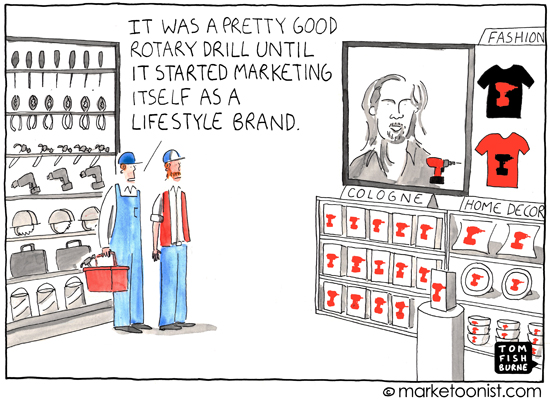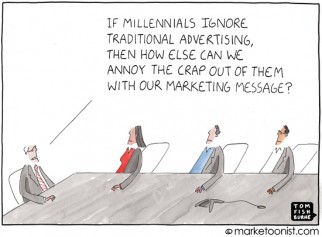Many brands aspire to become lifestyle brands. Lifestyle brands are seen as the pinnacle of marketing. Marketers elevate these brands beyond functional attribute to higher-order benefits. Consumers express their identities through these brands. This strategy promises differentiation and growth.
One of the reasons that method succeeded was its positioning as a lifestyle brand in the commodity category of household cleaning. Method wasn’t just a hand wash or a shower cleaner. It was a lifestyle brand that stood for something greater.
Yet the pursuit of becoming a lifestyle brand can also lead brands astray. It can give brands a false sense of confidence to stretch into other categories. It can cause brands to pay less attention to what really worked for consumers at the start. If they’re not careful, they risk diluting the brand.
One of my favorite brands is Hiut Denim. They may be a lifestyle brand, but they haven’t fallen into this trap. I particularly like their philosophy called “Do One Thing Well“:
“We make jeans. That’s it. Nothing else. No distractions. Nothing to steal our focus. No kidding ourselves that we can be good at everything. No trying to conquer the whole world. We just do our best to conquer our bit of it.”
Not every brand can or should become a Ralph Lauren. When elevating to higher-order benefits, it’s important that brands don’t lose sight of the product. Emotional benefits are shallow if there aren’t functional benefits to back them up.
(Marketoonist Monday: I’m giving away a signed print of this week’s cartoon. Just share an insightful comment to this week’s post by 5:00 PST on Monday. Thanks!)



Bill Carlson says
If method stands for more than being soap, that message has been lost on me… To me, pretty package but otherwise, just more liquid soap and BTW, I’ve refilled their container with the store brand alternative many times. (Perhaps the lifestyle I’m striving for is “looking good on the cheap?” 🙂
Okay, okay, sample size of one, probably the wrong demographic, whatever. Point is that you can try to make a brand out to be more than what it delivers, but not so sure we consumers are actually taking any of it seriously.
Coca Cola does not, contrary to advertising, increase your participation in beach volleyball games. I’ve had Dos Equis but not yet competing with “the most interesting man in the world.”
*Advertising* soap, pop or beer in some lifestyle context is to be expected, love those Dos Equis ads, but that’s different than taking yourself too seriously as a brand. And beware the risk of over-licensing — overdoing your name in the marketplace changes you from unique to commodity no matter what positioning you think you’re striving for.
All that said, I laughed about the jeans folks. Can picture the marketing folks/agency looking for the white space in the competitive matrix and landing on “hey! let’s promote the one thing we’re good at!”
Tracy Carlson says
Two unstated reasons underlie inappropriate efforts to become lifestyle brands, in my experience:
1) Unconscious snobbery: The brand leader/team (if not management overall) feel that straightforward, functional products aren’t very interesting. They don’t believe something inside the brand–the essence of what it actually does–could be compelling. Wanting their work to be “meaningful” they look outside the brand and stretch to try to make a connection between their offering and something they deem interesting, namely consumer’s lives.
2) Swilling the company KoolAid: When you spend your days focused on the tiny world of a product or service, you can lose perspective. You marinate in a world in which your brand matters a lot to you, your colleagues, and your company, and you can begin to wax grandiose. Besides, marketing people are generally young and ambitious, and overhyping your brand tends to play well politically.
Both of these smack of ego (personal, professional and/or company) and fail to serve a brand well. Having genuine respect–for the brand in its unvarnished essence, as well as for your consumers–is a much better platform for sustainable growth.
DSprogis says
Ralph Lauren went too far placing his logo on the olympic uniforms and, in my opinion, his retail shirts with the over-sized logo on the left breast.
In the case of the olympics, the uniform is supposed to be representative of the country represented; it is no place for a private brand.
In the case of the over-sized logo on the left breast – beyond garish – I’ve seen gang members with sutler logos.
Jennifer S Nelson says
What’s really interesting to me about Tom’s article and the subsequent comments so far is:
1. That Tom is calling method a lifestyle brand. I think of method as a savvy late entry into what was a (marketing wise) sleepy, somewhat commoditized category – and method’s approach became proof positive that there are no low engagement categories, just low engagement brands. So my skepticism that it’s a lifestyle brand is not an insult, it’s just that I think they’ve done a great job defining the brand and bringing that definition to life for consumers. It’s appropriately functional benefit based (done in a cool, fun and engaging way) – not lifestyle. They have a great tag line that is an excellent manifestation of the brand definition (“people against dirty”) — but not the ubiquity or overarching representation of a particular iconic or otherwise well known sub-culture that it would need to be a lifestyle brand.
Regardless of whether you buy that method is lifestyle or not, the advice: “When elevating to higher-order benefits, it’s important that brands don’t lose sight of the product” is completely spot on.
2. Tracy and Bill Carlson: are you guys married? Tracy, did you invite Bill to read one of your industry pubs? (all said in good humor…) because Bill, you read a little bit like the smart, non-marketing/non-advertising spouse of someone who is in brand management and/or advertising. We (most of us, at least) know consumers don’t really literally buy in to what we portray in ads – but if you look at the affinity differences for brands with a truly relevant and/or appealing/unique/funny representation in our ads, then you’ll know why we do this instead of just pitching very literal, purely functional claims in our advertising.
But, Bill’s advice that “overdoing your name in the marketplace changes you from unique to commodity no matter what positioning you think you’re striving for” is also spot on.
And Tracy, that makes you Bill’s advertising/marketing experienced spouse, who got it… well, spot on. Sadly, ego is a root cause of a lot of wasted resources (misguided, thus failed, line extensions and all that slob inventory, R&D investment, supply chain, advertising dollars).
I can recommend several different ways to use insights and analytics to both develop a massive range of possible brand/line extensions/revenue builders; and then I can help you qualify them so you choose the best one(s) for the best possible P&L, growth and/or profit. But you know what? A great way to start to figure out where your brand can extend in a financially and brand equity building smart way is to just ask: have our users asked us to make it? Never has it been so easy to “hear” what consumers that are interested in your brand genuinely want.
This comment post was inspired by Tom, Tracy, Bill and, just today on Instagram: EnjoyLife foods was featuring its new packaging for their soft cookies. And a brand afficianado spontaneously asked “do u guys sale (sic) cookie dough mix? Prefer to be in chocolate or sugar cookie??
John C says
Tracey, I think you are missing a third possibility: that senior management has dictated significant “growth” as a business objective, and the marketing team sees no other option than to change (or recapture) a premium market positioning.
I have one client who bought a small, challenger brand which had take then super-premium position in their category. Over the past several years, competitors have closed the gap in terms of packaging and language (either via extensions or new brands), whilst our client has shifted production from the challenger’s former facilities to their big factory facilities, changing the product itself in the process (and not in good ways).
With dwindling sales (and margins), they think recapturing their heyday as the super premium brand can get them a few points on the accounting ledger. But at the end of the day, the consumer has moved on because the core product is no longer special – which makes a lifestyle positioning dissonant to the consumer.
What’s the smart move? A new extension? Their own challenger brand? A re-investment in capital facilities?
Since the cost of any of those is well below doubling-down on a dying brand, you know what management has approved – evidence or principle be darned.
I think the brand, marketing and insights teams all know the truth, but senior management has dictated growth KPIs without any kool-aid or snobbery – just business. So the brand team is working with what they have.
tomfishburne says
Hi all,
I really enjoyed reading all of your insights, thanks! This week’s print goes to Tracy. I love the insight about swilling the company Kool-aid. I may need to draw a cartoon just about that!
-Tom
David@thebrandgym says
More genius Tom, and bang on target. Love it. Blog post here (corrected link): http://tinyurl.com/ksrvy67
Mike says
Love the ‘toon. Reminds me a certain tool company which has recently expanded their focus into clothing.
http://www.milwaukeetool.com/heated-gear